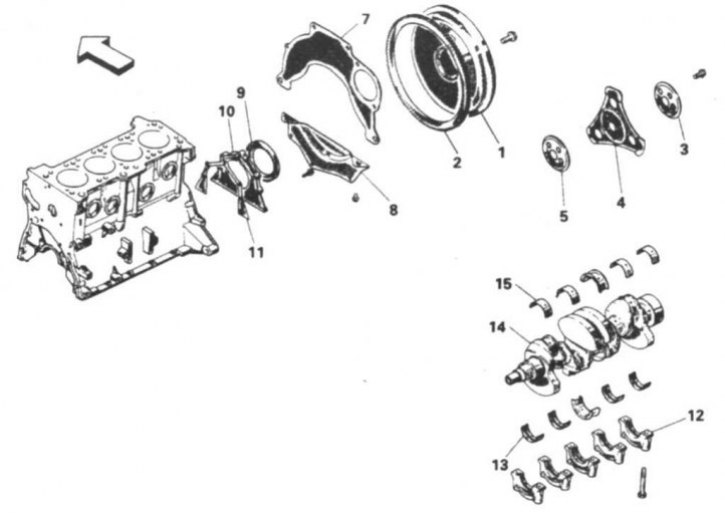2. Remove old loose leaves and wipe a surface of the block of cylinders and covers. They must be perfectly clean.
Checking the lubrication clearance of the main bearings
3. Establish loose leaves of bearings on the block of cylinders and covers of radical bearings. Groove liners are installed on the cylinder block, and lug liners are installed on the covers. Check that the lubrication holes in the cylinder block line up with the grooves in the bushings.

8.4 Engine internals
1. Flywheel*; 2. Ring gear*; 3. Adapter plate **; 4. Leading disk**; 5. Adapter plate**; 7. Back plate; 8. Clutch cover; 9. Rear oil seal; 10. Stuffing box; 11. Gasket; 12. Main bearing cap; 13. Lower main bearing shell; 14. Crankshaft; 15. Upper main bearing
* Vehicles with manual transmission
** Vehicles with automatic transmission
4. Thrust bearing shells with flanges must be installed on the center cover and cylinder block seat (8.4).
5. Wipe the surface of the bearings on the cylinder block and crankshaft journals with a clean cloth.
6. Check that the oil holes in the crankshaft are clean.
7. Carefully install the crankshaft on the bearings.
8' Bearing lubrication clearances must be checked before final installation of the crankshaft.

23.9 Lay the pieces of Plastigodge film (indicated by the shooter) on the main bearing journals parallel to the axis of the crankshaft
9. Cut off a few pieces of Plastigodge film (slightly shorter than the width of the main bearings) and place on each of the journals of the main bearings parallel to the axis of the crankshaft (23.9).
10. Clean the surface of the liners in the covers and install the covers in place, arrows towards the front of the engine.
11. Starting with the center cover, tighten the cover bolts in three steps to the correct torque. Do not rotate the crankshaft.
12. Turn off bolts and remove covers.

23.13 Measure the width of the crushed film
Plastigodge for determining the lubrication gap of a bearing
13. Compare the width of the crushed Plastigoge film on each of the necks with the scale included in the measuring kit (23.13).
14. If the gap is too large or too small, install different size bushings. Check that when measuring the lubrication gap between the liners and the covers or cylinder block, there is no dirt or oil. If the width of the crushed film is wider at one end than at the other, the crankshaft journal is likely tapered.
15. Carefully remove any remaining film from the necks and inserts.
Final installation of the crankshaft
16. Carefully remove the crankshaft from the engine.
17. Clean the bearings and lubricate them with an even layer of molybdenum grease. Also lubricate the thrust bearing flanges.
18. Check up, that necks of a cranked shaft were pure, and establish a cranked shaft on the engine.
19. Clean the surface of the liners on the covers and lubricate them.
20. Replace the covers with the arrows facing forward.
21. Install the mounting bolts.
22. Tighten all cap bolts except the thrust bearing cap to the correct torque (tighten the bolts in three stages, starting from the middle of the crankshaft).
23. Torque the thrust bearing cap bolts to 10-12 lb-in.
26. Move the crankshaft back and forth by tapping it with a copper hammer to align the thrust surfaces of the main bearing and crankshaft.
27. Tighten the bolts of all main bearing caps to the required torque.
28. On manual transmission models, install a new thrust bearing on the end of the axle shaft.
29. Turn the crankshaft by hand and check that it rotates freely.
30. Check the end play of the crankshaft.
